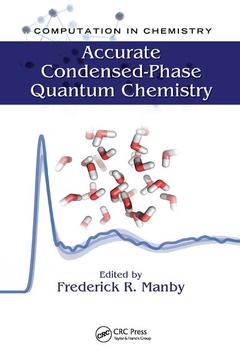Description
Accurate Condensed-Phase Quantum Chemistry
Computation in Chemistry Series
Coordinator: Manby Fred
Language: English
Subjects for Accurate Condensed-Phase Quantum Chemistry:
Keywords
Average Relative Absolute Error; Correlation Energy; Quantum chemistry; HF Energy; computational chemistry; Cohesive Energy; hierarchies of approximation; Water Hexamers; condensed-phase chemistry; FMO; Electronic Structure Theory; Correlation Contribution; Multipole Moments; Maximum Cluster Size; Lithium Hydride; DF; QM Calculation; Phonon Dispersion Curves; Laplace Transform; Condensed Phase Systems; Monte Carlo Move; Ta Te; Ei Jk; Unsigned Errors; Adsorption Energy; Band Gap; Symmetry Adapted Perturbation Theory; MC; post-Hartree Fock Methods
Publication date: 09-2018
· 15.6x23.4 cm · Paperback
Publication date: 09-2010
232 p. · 15.6x23.4 cm · Hardback
Description
/li>Contents
/li>Readership
/li>Biography
/li>
The theoretical methods of quantum chemistry have matured to the point that accurate predictions can be made and experiments can be understood for a wide range of important gas-phase phenomena. A large part of this success can be attributed to the maturation of hierarchies of approximation, which allow one to approach very high accuracy, provided that sufficient computational resources are available. Until recently, these hierarchies have not been available in condensed-phase chemistry, but recent advances in the field have now led to a group of methods that are capable of reaching this goal.
Accurate Condensed-Phase Quantum Chemistry addresses these new methods and the problems to which they can be applied. The book begins with an overview of periodic treatments of electron correlation, with an emphasis on the algorithmic features responsible for their computational efficiency. The first section of the book:
- Describes the Laplace-transform approach to periodic second-order perturbation theory (MP2)
- Examines local and density fitted schemes for MP2 in crystalline systems
- Presents test calculations for a variety of systems with small and medium-sized unit cells
The next section focuses on methods based on treatment of the periodic solid in terms of fragments. This part of the book:
- Explores the incremental many-body scheme for electron correlation in solids, and describes progress towards metals and molecules on surfaces
- Describes the hierarchical method as an alternative fragment-based approach to electron correlation in crystalline solids, using conventional molecular electronic structure methods
- Examines electrostatically embedded many-body expansion for large systems, with an emphasis on molecular clusters and molecular liquids
- Explores delocalized and localized orbital approaches to the electronic structures of periodic and non-periodic solids
Lastly, the book describes a practical method by which conventional molecular electronic structure theory can be applied to molecular liquids and solids. Along with the methodology, it presents results on small to medium water clusters as well as on liquid water.
Laplace transform second-order Møller-Plesset methods in the atomic orbital basis for periodic systems. Density fitting for correlated calculations in periodic systems. The method of increments—a wavefunction-based correlation method for extended systems. The hierarchical scheme for electron correlation in crystalline solids. Electrostatically embedded many-body expansion for large systems. Electron correlation in solids: delocalized and localized orbital approaches. Ab-initio Monte-Carlo simulations of liquid water.
Frederick R. Manby is a Reader in the Centre for Computational Chemistry in the School of Chemistry at the University of Bristol, and was previously a Royal Society University Research Fellow. His research has focused on two main areas: first, on the development of efficient and accurate electronic structure methods for large molecules. Second, he has worked on the accurate treatment of condensed-phase systems, including electron correlation in crystalline solids, and on the application of wavefunction-based electronic structure theories to molecular liquids, particularly water. Dr. Manby was awarded the Annual Medal of the International Academy of Quantum Molecular Sciences (2007) and the Marlow Medal of the Royal Society of Chemistry (2006) in recognition of his research on molecular electronic structure theory.




